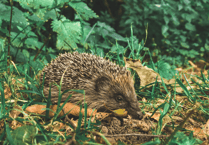The cushag plant (senecio jacobaea), also known as common ragwort, is a native species to the Isle of Man and it is regarded as our national flower. Do you love or hate this controversial plant?
The chances are if you own livestock you will hate it because it is poisonous if eaten in sufficient quantity, leading it to be classed as an ‘injurious weed’ under the UK’s Weeds Act 1959.
Generally speaking, as long as there is sufficient grass or forage for livestock to eat, they avoid any ragwort growing in their field (it’s thought they find it bitter and unpalatable). But if the plant is allowed to grow in fields that are then used for hay or haylage harvesting it becomes a hidden danger because the animals eating it don’t know it’s there.
It affects horses more than other livestock, and it can prove fatal if eaten in sufficient quantity because it contains alkaloids that cause cirrhosis of the liver, and there is no known antidote.
Ragwort is a common sight on the Island at this time of year when it is in its prime, with its bright yellow flowers growing on long, leafy stems of around a meter in height.
A single stalk with its multiple flowers can produce 200,000 seeds in one season. They can survive in the soil for up to 16 years awaiting an opportunity to grow. The seeds themselves are also poisonous.
Pulling or digging up the ragwort plant with its roots intact and then burning it is the most effective way to control it, but you should wear gloves and cover your arms and legs to protect yourself from the plant’s toxicity.
But is it right to demonise ragwort? Conservationists argue that there is a need for ragwort to remain in our countryside because it is important for wildlife, not least because if its long flowering period – it can continue to flower well into November, long after other flowers have gone to seed and disappeared.
It supports more than 120 types of invertebrate, and it is a major nectar source for many insects. It is a natural component of natural grassland and many would argue that it need not be removed from land unless it is used for forage production.
Another very important reason to preserve ragwort involves the cinnabar caterpillar - like the one pictured, alongside a bee, on a plant at Gansey.
The caterpillar relies upon ragwort for its existence and thrives on its poisonous properties. Indeed, it absorbs the ragwort toxins as a caterpillar and then become poisonous itself as it metamorphises into a moth.
This is why the moth’s wings are red and black in colour – a sure sign to birds that they should avoid eating this species.
A single brood of cinnabar caterpillars can devour a whole ragwort plant in a day, and over their life cycle they can consume more than 30 plants.
A collapse in cinnabar moth numbers in the late 1980s is thought to be a factor in the subsequent build-up of ragwort, and so scientists are now looking for ways to re-establish the moth as a long-term and environmentally friendly way of curbing ragwort numbers.
It is, perhaps, fitting that this controversial plant became the Isle of Man’s national flower as a way of criticising the island rather than celebrating it. Its status is reputed to have been bestowed by Lord Raglan, Governor of the island from 1902-1918.
When asked to pick a national flower, as was the fashion in other places at the time, in jest and as a slight on how he viewed the condition of the countryside at the time (i.e. full of weeds), he suggested that cushag, a.k.a. ragwort, would be a fitting species.
The joke appears to have been lost over the years, but the concept of cushag as our national flower remains.


.jpeg?width=209&height=140&crop=209:145,smart&quality=75)
.jpeg?width=209&height=140&crop=209:145,smart&quality=75)

Comments
This article has no comments yet. Be the first to leave a comment.